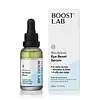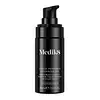What's inside
What's inside
 Key Ingredients
Key Ingredients

 Benefits
Benefits

 Concerns
Concerns

 Ingredients Side-by-side
Ingredients Side-by-side

Water
Skin ConditioningGlycerin
HumectantPentylene Glycol
Skin ConditioningDunaliella Salina Extract
Skin ConditioningPanthenol
Skin ConditioningMagnesium Aspartate
Skin ConditioningZinc Gluconate
Skin ConditioningCopper Gluconate
Skin ConditioningSodium Hyaluronate
HumectantPalmitoyl Tripeptide-5
Skin ConditioningHesperidin Methyl Chalcone
AntioxidantPantolactone
HumectantDipeptide-2
Skin ConditioningPalmitoyl Tetrapeptide-7
Skin ConditioningXanthan Gum
EmulsifyingSteareth-20
CleansingPolyacrylate Crosspolymer-6
Emulsion StabilisingTrisodium Ethylenediamine Disuccinate
Citric Acid
BufferingPhenoxyethanol
PreservativeEthylhexylglycerin
Skin ConditioningT-Butyl Alcohol
PerfumingSodium Benzoate
MaskingPotassium Sorbate
PreservativeWater, Glycerin, Pentylene Glycol, Dunaliella Salina Extract, Panthenol, Magnesium Aspartate, Zinc Gluconate, Copper Gluconate, Sodium Hyaluronate, Palmitoyl Tripeptide-5, Hesperidin Methyl Chalcone, Pantolactone, Dipeptide-2, Palmitoyl Tetrapeptide-7, Xanthan Gum, Steareth-20, Polyacrylate Crosspolymer-6, Trisodium Ethylenediamine Disuccinate, Citric Acid, Phenoxyethanol, Ethylhexylglycerin, T-Butyl Alcohol, Sodium Benzoate, Potassium Sorbate
Water
Skin ConditioningGlycerin
HumectantDimethicone
EmollientDimethyl Isosorbide
SolventButylene Glycol
HumectantUndecane
EmollientArginine
MaskingInulin
Skin ConditioningMicrocrystalline Cellulose
AbsorbentCeteareth-20
CleansingTridecane
PerfumingTocopherol
AntioxidantHydroxyacetophenone
AntioxidantSodium Hyaluronate
HumectantPalmitoyl Tripeptide-38
Skin ConditioningPanthenol
Skin ConditioningCaprylic/Capric Triglyceride
MaskingPalmitoyl Tripeptide-5
Skin ConditioningPolyacrylate Crosspolymer-6
Emulsion StabilisingPalmitoyl Tripeptide-1
Skin ConditioningPullulan
Tetrapeptide-21
Skin ConditioningPalmitoyl Tetrapeptide-10
Skin ConditioningPalmitoyl Tetrapeptide-7
Skin ConditioningAmmonium Polyacryloyldimethyl Taurate
Emulsion StabilisingGlyceryl Linoleate
EmollientAcetyl Hexapeptide-8
HumectantPentapeptide-18
Skin ConditioningOligopeptide-1
Skin ConditioningArginine/Lysine Polypeptide
Skin ConditioningSucrose Palmitate
EmollientCetyl Palmitate
EmollientPhenoxyethanol
PreservativeEthylhexylglycerin
Skin ConditioningCarbomer
Emulsion StabilisingCopper Palmitoyl Heptapeptide-14
Skin ConditioningHeptapeptide-15 Palmitate
Skin ConditioningBenzotriazolyl Dodecyl P-Cresol
UV AbsorberPolysorbate 80
EmulsifyingSorbitan Stearate
EmulsifyingPolysorbate 20
EmulsifyingCarnosine
Skin ConditioningSodium Metabisulfite
AntioxidantDunaliella Salina Extract
Skin ConditioningHelianthus Annuus Seed Oil
EmollientHydroxypropyl Cyclodextrin
MaskingDimethicone/Vinyl Dimethicone Crosspolymer
Skin ConditioningSodium Benzoate
MaskingHydrogenated Lecithin
EmulsifyingCaprylyl Glycol
EmollientPantolactone
HumectantXanthan Gum
EmulsifyingDisodium EDTA
T-Butyl Alcohol
PerfumingPotassium Sorbate
PreservativeCitric Acid
BufferingGlyceryl Caprylate
EmollientLactic Acid/Glycolic Acid Copolymer
Skin ConditioningPolyvinyl Alcohol
Phenylpropanol
MaskingWater, Glycerin, Dimethicone, Dimethyl Isosorbide, Butylene Glycol, Undecane, Arginine, Inulin, Microcrystalline Cellulose, Ceteareth-20, Tridecane, Tocopherol, Hydroxyacetophenone, Sodium Hyaluronate, Palmitoyl Tripeptide-38, Panthenol, Caprylic/Capric Triglyceride, Palmitoyl Tripeptide-5, Polyacrylate Crosspolymer-6, Palmitoyl Tripeptide-1, Pullulan, Tetrapeptide-21, Palmitoyl Tetrapeptide-10, Palmitoyl Tetrapeptide-7, Ammonium Polyacryloyldimethyl Taurate, Glyceryl Linoleate, Acetyl Hexapeptide-8, Pentapeptide-18, Oligopeptide-1, Arginine/Lysine Polypeptide, Sucrose Palmitate, Cetyl Palmitate, Phenoxyethanol, Ethylhexylglycerin, Carbomer, Copper Palmitoyl Heptapeptide-14, Heptapeptide-15 Palmitate, Benzotriazolyl Dodecyl P-Cresol, Polysorbate 80, Sorbitan Stearate, Polysorbate 20, Carnosine, Sodium Metabisulfite, Dunaliella Salina Extract, Helianthus Annuus Seed Oil, Hydroxypropyl Cyclodextrin, Dimethicone/Vinyl Dimethicone Crosspolymer, Sodium Benzoate, Hydrogenated Lecithin, Caprylyl Glycol, Pantolactone, Xanthan Gum, Disodium EDTA, T-Butyl Alcohol, Potassium Sorbate, Citric Acid, Glyceryl Caprylate, Lactic Acid/Glycolic Acid Copolymer, Polyvinyl Alcohol, Phenylpropanol
 Reviews
Reviews

Ingredients Explained
These ingredients are found in both products.
Ingredients higher up in an ingredient list are typically present in a larger amount.
Citric Acid is an alpha hydroxy acid (AHA) naturally found in citrus fruits like oranges, lemons, and limes.
Like other AHAs, citric acid can exfoliate skin by breaking down the bonds that hold dead skin cells together. This helps reveal smoother and brighter skin underneath.
However, this exfoliating effect only happens at high concentrations (20%) which can be hard to find in cosmetic products.
Due to this, citric acid is usually included in small amounts as a pH adjuster. This helps keep products slightly more acidic and compatible with skin's natural pH.
In skincare formulas, citric acid can:
While it can provide some skin benefits, research shows lactic acid and glycolic acid are generally more effective and less irritating exfoliants.
Most citric acid used in skincare today is made by fermenting sugars (usually from molasses). This synthetic version is identical to the natural citrus form but easier to stabilize and use in formulations.
Read more about some other popular AHA's here:
Learn more about Citric AcidWe don't have a description for Dunaliella Salina Extract yet.
Ethylhexylglycerin (we can't pronounce this either) is commonly used as a preservative and skin softener. It is derived from glyceryl.
You might see Ethylhexylglycerin often paired with other preservatives such as phenoxyethanol. Ethylhexylglycerin has been found to increase the effectiveness of these other preservatives.
Glycerin is already naturally found in your skin. It helps moisturize and protect your skin.
A study from 2016 found glycerin to be more effective as a humectant than AHAs and hyaluronic acid.
As a humectant, it helps the skin stay hydrated by pulling moisture to your skin. The low molecular weight of glycerin allows it to pull moisture into the deeper layers of your skin.
Hydrated skin improves your skin barrier; Your skin barrier helps protect against irritants and bacteria.
Glycerin has also been found to have antimicrobial and antiviral properties. Due to these properties, glycerin is often used in wound and burn treatments.
In cosmetics, glycerin is usually derived from plants such as soybean or palm. However, it can also be sourced from animals, such as tallow or animal fat.
This ingredient is organic, colorless, odorless, and non-toxic.
Glycerin is the name for this ingredient in American English. British English uses Glycerol/Glycerine.
Learn more about GlycerinPalmitoyl Tetrapeptide-7 (formerly Palmitoyl Tetrapeptide-3) is a lab-made peptide with anti-inflammatory and skin-repairing benefits. It's made up of four amino acids (glycine, glutamine, proline, and arginine) and palmitic acid (which helps it penetrate skin more effectively).
This ingredient helps reduce inflammation by limiting the production of interleukin-6 (IL-6), a chemical that triggers inflammatory responses, particularly after UV exposure.
Less inflammation = slower collagen breakdown and a longer-lasting, youthful appearance.
Palmitoyl Tetrapeptide-7 also stimulates collagen production and supports a healthier skin barrier.
Over time, this can improve skin firmness, hydration, and reduce the appearance of fine lines. It’s commonly paired with Palmitoyl Tripeptide-1 in the well-known Matrixyl 3000 complex for enhanced anti-aging effects.
This ingredient has been shown to be effective and safe in cosmetic use and you'll typically find it in small amounts (less than 0.01%).
Due to its palmitic acid base, it may not be safe for Malassezia folliculitis.
Read more about other common types of peptides here:
Learn more about Palmitoyl Tetrapeptide-7This synthetic peptide is created from lysine, valine, and palmitic acid.
According to the manufacturer, in-vitro studies show tissue growth and collagen synthesis. Another in-vivo study found 60 volunteers saw a significant reduction in wrinkles after 84 days.
Due to its palmitic acid base, this peptide may not be fungal-acne safe.
Learn more about Palmitoyl Tripeptide-5Panthenol is a common ingredient that helps hydrate and soothe the skin. It is found naturally in our skin and hair.
There are two forms of panthenol: D and L.
D-panthenol is also known as dexpanthenol. Most cosmetics use dexpanthenol or a mixture of D and L-panthenol.
Panthenol is famous due to its ability to go deeper into the skin's layers. Using this ingredient has numerous pros (and no cons):
Like hyaluronic acid, panthenol is a humectant. Humectants are able to bind and hold large amounts of water to keep skin hydrated.
This ingredient works well for wound healing. It works by increasing tissue in the wound and helps close open wounds.
Once oxidized, panthenol converts to pantothenic acid. Panthothenic acid is found in all living cells.
This ingredient is also referred to as pro-vitamin B5.
Learn more about PanthenolPantolactone is a synthetically created humectant.
As a humectant, Pantolactone helps draw moisture to the skin. It can help add hydration to your skin.
Phenoxyethanol is a preservative that has germicide, antimicrobial, and aromatic properties. Studies show that phenoxyethanol can prevent microbial growth. By itself, it has a scent that is similar to that of a rose.
It's often used in formulations along with Caprylyl Glycol to preserve the shelf life of products.
Polyacrylate Crosspolymer-6 is a texture enhancer and pH adjuster.
It is be used to thicken water-based products and create a gel-texture with a velvet feel.
One manufacturer claims this ingredient to have a pH range of 2-8 and to be biodegradable.
Learn more about Polyacrylate Crosspolymer-6Potassium Sorbate is a preservative used to prevent yeast and mold in products. It is commonly found in both cosmetic and food products.
This ingredient comes from potassium salt derived from sorbic acid. Sorbic acid is a natural antibiotic and effective against fungus.
Both potassium sorbate and sorbic acid can be found in baked goods, cheeses, dried meats, dried fruit, ice cream, pickles, wine, yogurt, and more.
You'll often find this ingredient used with other preservatives.
Learn more about Potassium SorbateSodium Benzoate is a preservative. It's used in both cosmetic and food products to inhibit the growth of mold and bacteria. It is typically produced synthetically.
Both the US FDA and EU Health Committee have approved the use of sodium benzoate. In the US, levels of 0.1% (of the total product) are allowed.
Sodium benzoate works as a preservative by inhibiting the growth of bacteria inside of cells. It prevents the cell from fermenting a type of sugar using an enzyme called phosphofructokinase.
It is the salt of benzoic acid. Foods containing sodium benzoate include soda, salad dressings, condiments, fruit juices, wines, and snack foods.
Studies for using ascorbic acid and sodium benzoate in cosmetics are lacking, especially in skincare routines with multiple steps.
We always recommend speaking with a professional, such as a dermatologist, if you have any concerns.
Learn more about Sodium BenzoateSodium Hyaluronate is hyaluronic acid's salt form. It is commonly derived from the sodium salt of hyaluronic acid.
Like hyaluronic acid, it is great at holding water and acts as a humectant. This makes it a great skin hydrating ingredient.
Sodium Hyaluronate is naturally occurring in our bodies and is mostly found in eye fluid and joints.
These are some other common types of Hyaluronic Acid:
Learn more about Sodium HyaluronateT-Butyl Alcohol it is most commonly used as a solvent.
At room temperature, T-Butyl Alcohol melts and has a similar smell to camphor.
This ingredient is derived from isobutane. It is the simplest form of a tertiary alcohol. Due to its chemical structure, it is more resistant to oxidation.
Some sources online claim T-Butyl Alcohol is a fatty alcohol. However, it is not considered one due to its chemical structure.
Learn more about T-Butyl AlcoholWater. It's the most common cosmetic ingredient of all. You'll usually see it at the top of ingredient lists, meaning that it makes up the largest part of the product.
So why is it so popular? Water most often acts as a solvent - this means that it helps dissolve other ingredients into the formulation.
You'll also recognize water as that liquid we all need to stay alive. If you see this, drink a glass of water. Stay hydrated!
Learn more about WaterXanthan gum is used as a stabilizer and thickener within cosmetic products. It helps give products a sticky, thick feeling - preventing them from being too runny.
On the technical side of things, xanthan gum is a polysaccharide - a combination consisting of multiple sugar molecules bonded together.
Xanthan gum is a pretty common and great ingredient. It is a natural, non-toxic, non-irritating ingredient that is also commonly used in food products.
Learn more about Xanthan Gum